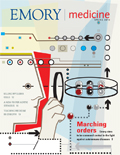Lining up chemotherapy and radiation
 |
For patients with non-small cell lung cancer or a rare type of brain tumor, how they receive chemotherapy and radiation therapy may help determine survival time, according to Emory researchers.
More patients who received chemotherapy and radiation therapy concurrently lived longer than those who received the treatment in sequence, two studies found.
Of patients with non-small cell lung cancer who received concurrent treatment, 16% were living after five years compared with 10% of patients who received therapies sequentially, says Walter Curran, the study’s principal investigator and executive director of Emory’s Winship Cancer Institute.
Curran also served as senior author on a second study comparing survival times of patients with anaplastic oligodendroglioma, a rare brain tumor, containing a genetic abnormality known as 1p19q co-deletion. For this group of patients, the addition of chemotherapy to radiation therapy nearly doubled their median survival time, 14.7 years compared with 7.3 years for those who received radiation alone.
Regardless of treatment assignment, however, patients whose tumors carried the 1p19q co-deletion survived significantly longer than patients whose tumors did not have the co-deletion (more than 7 years versus 2.8 years).
Both studies suggest a new treatment protocol, says Curran, the Lawrence Davis Chair in Radiation Oncology.
Curran recently was ranked number 22 among 35,000 researchers nationwide in National Institutes of Health funding in 2011. Curran, whose NIH funding totaled more than $16 million, is the only researcher in Georgia and the only NCI-designated cancer center director to be among the top 25 in NIH grant funding.


